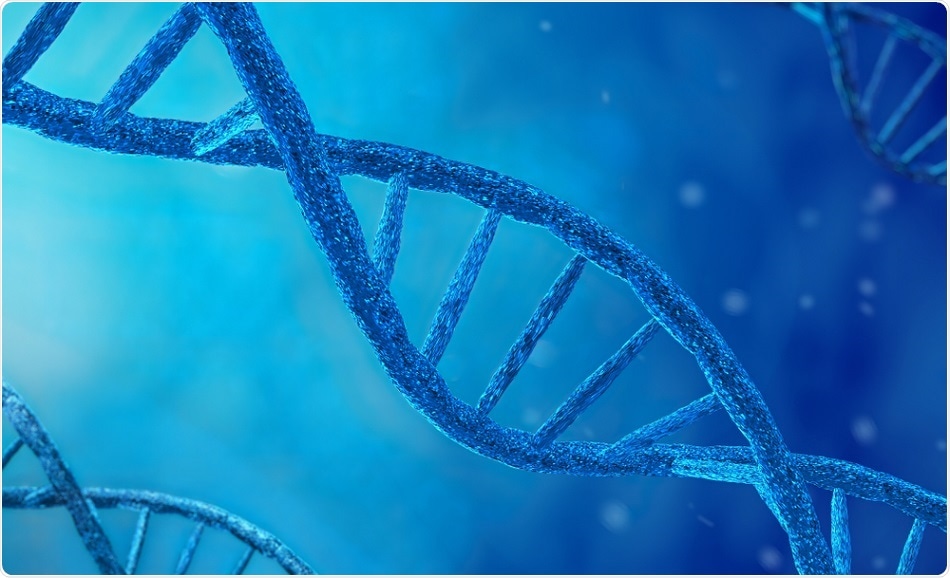A new study published in Nature Structural & Molecular Biology reveals how the fundamental enzyme called DNA polymerase delta operates during DNA replication, making a copy of the genetic code that can be transmitted through the generations. In addition, the researchers also describe how the level of activity of this enzyme is affected by mutations that result in cancers and other illnesses.
 acarapi | Shutterstock
acarapi | Shutterstock
Calling DNA polymerase delta the “duplicating machine”, the researchers present a picture of the whole enzyme at an almost atomic level while it is synthesizing new DNA.
This knowledge furthers our basic understanding of this complex enzyme which is essential for survival in higher organisms from humans to yeast. At the same time, our work provides insights into how cancers can arise when DNA polymerase delta is not functioning properly, and offers a novel basis for designing inhibitors of the polymerase that could potentially serve as effective treatment in certain cancers."
Researcher Aneel Agarwal
DNA polymerase delta
Many researchers have wondered about the structure and dynamic working of the enzyme over the decades. The enzyme is a complex cellular machine by itself, bringing together a host of components to make a copy with incredibly precise accuracy. This requires several processes: surveillance of the copy formation, signaling of any inaccuracies or breaks, and repair of damaged sequences.
DNA polymerase delta helps not only to replicate the major part of the genome, but is also active in multiple DNA repair pathways. The polymerase delta acts on the lagging strand of DNA during replication, along with many other replication factors and repair proteins, to correct inaccuracies to less than a single wrong base per replication cycle. By virtue of its peculiar structure, it also helps to bypass damaged parts of the double helix when DNA synthesis must continue over sequences that include these lesions. Without this, the replication sequence would come to a halt, because the replication fork cannot progress beyond a collapsed fork or broken strand.
The DNA polymerase delta enzyme selects the right bases, and proofreads the sequences formed, as well as helping to repair the rare errors. The enzyme is composed of a core made up of p125 and P50 domains, which forms a complex with either of the domains p68 or p12. The core enzyme is stimulated by a factor called PCNA, the proliferating cell nuclear antigen.
The p125 domain is oriented like a right hand, with the ‘palm’ part providing the side chains that catalyze replication, while the ‘thumb’ holds the new duplex DNA tightly. The stability of the holoenzyme is to a large extent due to the p125 domains.
In addition to its replicative role, the DNA polymerase delta enzyme also catches wrong base substitutions and frameshifts to correct them by acting with mismatch repair enzymes to correct any misincorporated bases. It is also necessary to take part in the repair of various other forms of potential mutation like double-strand break repair, base excision repair and nucleotide excision repair.
How did they do it? The researchers in the current study used new techniques developed in cryoelectron microscopy, which takes images of dissolved molecules that have been rapidly frozen. This avoids the use of dyes and fixatives, allowing specimens to be seen in their native state. This technology is creating waves in the study of biological structure because of the high-resolution images it offers, of intracellular fine structure, viruses, and protein complexes. Using such techniques, the researchers looked at the enzyme almost atom by atom, as well as the way various components move about to facilitate the process of replicating the billions of base pairs that make up the double helix, in accurate succession and position.
Mutations of Pol delta
The team also shows the location and effect of several mutations of this enzyme, passed down from parent to offspring, as well as somatic mutations that occur not in the reproductive cells but in the cells of various tissues, and are usually due to chance. The presence of mutations causes the enzyme to become hypermutated. In this form, the enzyme may cause cancer as well as the mandibular hypoplasia, deafness, and lipodystrophy syndrome.
The researchers want to continue to work on this enzyme, and find inhibitor compounds that could help treat cancers caused by the mutated form of the enzyme. For instance, molecules that bind with the p12 unit could prevent the enzyme from binding to the catalytic subunit, or inhibitors that block replication by binding to the domain where p125 interacts with p68. The ability to inhibit this enzyme could also cause lethal damage to a large number of cancers that show multiple varieties of DNA repair defects.
Journal reference:
DNA polymerase delta in DNA replication and genome maintenance. Marc J. Prindle, and Lawrence A. Loeb. Environmental and Molecular Mutagenesis. 2012 Dec; 53(9): 666–682. Published online 2012 Oct 13. doi: 10.1002/em.21745. https://www.ncbi.nlm.nih.gov/pmc/articles/PMC3694620/